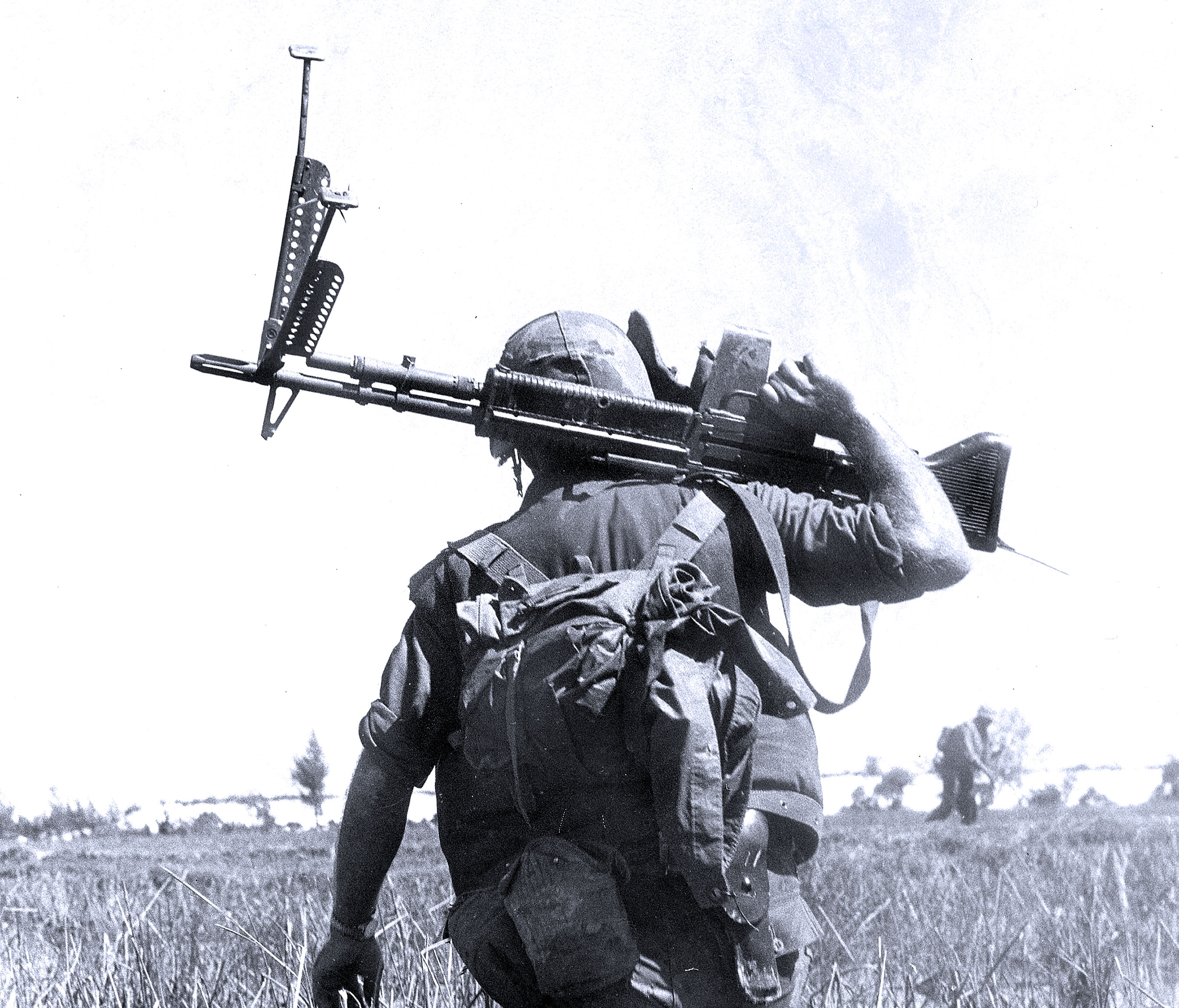Most war stories are about soldiers and battles. Rarely do we examine war through the unique bond between a man and his weapon—in this case the M60 machine gun. I was drafted on Nov. 10, 1965, and assigned to the 4th Infantry Division. I traveled to Fort Lewis, Washington, and trained there for 10 months before deploying to Vietnam as specialist 4. At Fort Lewis, every recruit learned to operate various weapons.
To my surprise, I qualified as an expert with the M60 machine gun, nicknamed “the pig” because of the size, weight and sound of the weapon.
At that time, an infantry company consisted of about 150 men. Each company had eight M60s. The machine gun was also mounted in the UH-1 Huey helicopter and other Army aircraft. It weighed 24 pounds, was 43.5 inches long and had bipod legs that folded down to stabilize the weapon when firing from a prone position. The gas-operated, belt-fed gun had a maximum rate of fire of 550-650 rounds per minute.
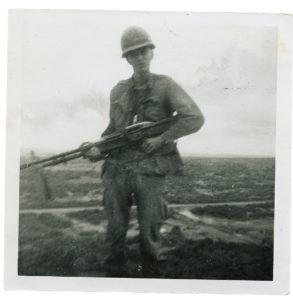
In the hands of a well-trained machine gunner, the M60 was a devastating weapon—so feared by our opponents that they usually aimed their first shots at the machine gunners, who were often in positions exposed to enemy fire. We were told in training that the life expectancy of a machine gunner was about seven seconds from the moment the first round was fired.
When I was assigned to the M60 in advanced individual training, I decided that if I had to be a gunner I would learn everything there was to know about the weapon. Soon I could take the gun apart and put it back together in the dark. To keep busy on the boat ride to Vietnam, my unit—Company B, 1st Battalion, 8th Infantry Regiment—held competitions where we took the gun apart and put it back together while blindfolded to see who could do it fastest. I won a few times, and even when I did not I benefited from handling the gun under stress. By the time we reached Vietnam in October 1966 I felt the gun had become a part of me.
Company B arrived in-country with four rifle platoons, and each platoon was armed with two M60s. The machine guns were numbered within each platoon. I was in 2nd Platoon and carried the platoon’s “No. 1 Gun.” I had an assistant gunner, Spc. 4 Paul Domke, who carried extra belts of ammo and fed them into the gun. Two of my closest friends in the company, Spc. 4 Bill May and Spc. 4 Charlie Ranallo, were on “No. 2 Gun.”
I personally carried 300 rounds of ammo at all times, one belt in the gun and two across my chest. My assistant gunner and my ammo bearer also carried 300 rounds each. I didn’t make a move without that gun beside me.
Our battalion operated at a base camp near Tuy Hoa in Phu Yen province along the South China Sea from October 1966 to January 1967. We had run patrols for about a month when I first saw action. I had yet to fire a shot with No. 1 gun and was hoping it would stay that way.
Then one hot, sunny day, while walking across rice paddies, we suddenly received small-arms fire from Viet Cong in some distant hills. Everyone in the company hit the dirt. We could not see any enemy soldiers, but we could see smoke coming from their weapons through the trees. Knowing I had a 100-round belt in my M60, I opened up on that hillside, my gun getting so hot that the barrel smoked. Suddenly I realized that my platoon sergeant was screaming at me to stop firing. I was wasting ammo and didn’t even have a target! I may not have hit anyone that day, but I am certain that No. 1 Gun kept a lot of enemy heads down.
After a couple of hours, the Viet Cong stopped shooting and melted back into the jungle. No. 1 Gun and I survived our first firefight. Together we had passed the test. I also earned a Combat Infantryman Badge, signifying that I had been actively engaged in combat. If it had been up to me, I would have awarded my gun the CIB too.
In the few firefights and skirmishes we had with local VC, the gun always performed well. No. 1 Gun became my very best friend. One afternoon, while Company B was still in the Tuy Hoa area, we received orders to gather up our gear and get ready to board choppers for an assault into a hot landing zone. The battalion was sending us to a village with a small river running through it.
Enemy fire greeted as us as soon as we landed near the village. Half of the company hopped off the Huey on one side of the river, and the rest exited on the other side. Both halves quickly swept toward the river to clear the village. Supported by a shoulder strap, No. 1 Gun was on my hip with the safety off, ready to rock and roll. As I made my way to the river, I saw a VC guerrilla jump into the water on the other side. A dense mass of elephant grass hung over the riverbank, and he ducked under it.
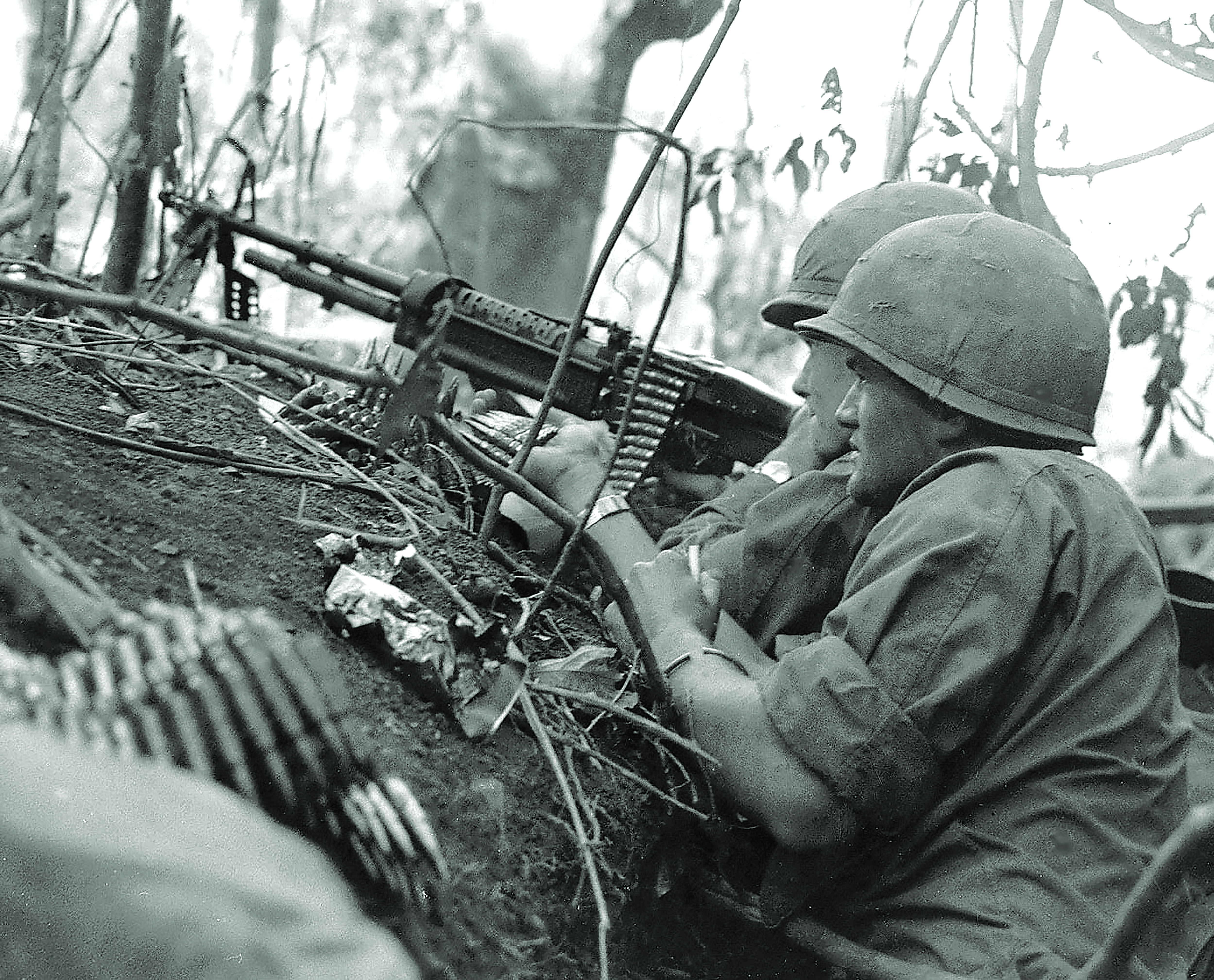
Anxiously extending the bipod legs on the M60, I added a 100-round belt to the one I already had in the gun. I wasn’t sure if the VC had moved to right or left, so I sprayed the elephant grass in both directions. I pumped 200 rounds into that riverbank. When the Company B units that landed on the opposite side of the river got to the bank, some troops reached in and pulled the enemy from the water. His body was torn to pieces.
“What the hell did you hit him with?” one of our men shouted. Proudly holding my M60 over my head, I screamed at the top of my lungs, “No. 1 gun!” Everyone laughed.
No. 1 Gun had registered its first kill. It was very nearly my last. As I was running to the river’s edge, ready to unload on the VC hiding in the elephant grass, I ran past a grass hut and never bothered to clear it. Lowering my gun, I turned around and noticed two VC sitting in the doorway of the hut, staring at me. One was holding a carbine. Startled, I quickly pointed my M60 at them. The man with the carbine immediately dropped it, and the two VC surrendered. It was the silent power of the pig, I suppose.
In January 1967, the 1st Battalion, 8th Infantry, was airlifted to Pleiku province in the Central Highlands. No. 1 Gun and I now faced a new and more formidable foe—the North Vietnamese Army. We soon learned that the NVA troops were very different from the local guerrillas we had fought around Tuy Hoa. They were well-armed, well-trained and knew how to fight. I had to rely on my gun more than before.
Over the next two months, we exchanged fire with groups of the NVA. On the morning of March 22, 1967, companies A and B of my battalion began a search-and-destroy operation along the Cambodian border. We were about 700 yards east of Company A when it was ambushed by an NVA battalion. Ordered to reinforce the unit, the Company B commander put our four platoons abreast of each other, and we marched west.
As we approached the battle, we heard intense firing. The NVA had wedged a blocking force between our company and Company A, preventing us from advancing any farther.
Hurrying forward with No. 1 Gun, I jumped into a small dry streambed with Domke, my assistant gunner. Sgt. Arthur Parker and Spc. 4 Joey Piambino were to my right in the streambed. The three of us had trained together at Fort Lewis and were good friends. I put the M60’s bipod legs down, lifted the weapon and positioned it on the ground outside the streambed facing the NVA.
Then I dropped back down in the streambed to organize our ammo. When I popped back up to put out some automatic fire, a bullet whizzed by my ear—no more than an inch from my head—and slammed into the tree next to me, shattering the bark. An NVA soldier had evidently spotted the gun and waited patiently for me to stick my head up. I never even got a shot off.
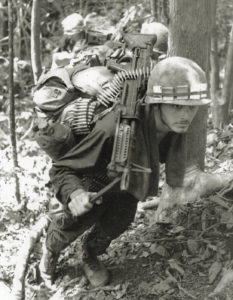
Terrified, I dropped down as fast as I could, pulling the gun and two ammo belts of 100 rounds apiece on top of me as I fell back into the dry streambed. My heart was pounding out of my chest. Still shaken, I grabbed the gun and crawled to the left inside the streambed. Eventually I found a spot where the bed leveled off and began firing on the NVA. No. 1 Gun, as always, thumped out a throaty roar as I fought desperately to push the enemy back.
To my right, Piambino had poked his head out of the trench to fire his M16 rifle. As soon as he did, a round hit him in the forehead, blowing out the back of his skull. I am convinced the same NVA soldier who shot at me moments before had killed my good friend, a budding doo-wop singer from Long Island, New York.
Unable to reach Company A, my company pulled back, formed a perimeter and called in air and artillery support. Suddenly, I heard my name shouted from the Company B command group. I picked up my M60 and walked to the center of the perimeter, where I found the company commander, Capt. Robert Sholly, standing with Platoon Sgt. Bruce Grandstaff and my best friend, Sgt. Bob Sanzone. The 4th Platoon’s single machine gun crew—the platoon had entered the fight short a gun—had been killed in the fighting, and I was to be moved there.
Naturally I was excited at the opportunity to join Sanzone, but at the same time I hated leaving 2nd Platoon’s No. 2 Gun team, Ranallo and May, without any support. More importantly, Grandstaff was very gung-ho. I worried about that kind of leadership style in the highlands.
I was still pondering the move to 4th Platoon when U.S. Air Force jets screamed over the treetops with canisters of napalm. Tumbling end over end, the canisters exploded in a white-hot fireball. The rolling fire burned everything to the ground and undoubtedly killed scores of NVA. The enemy fire ceased, and we made arrangements to collect our dead before continuing on to Company A.
Company B had seven dead, Grandstaff announced, and I was to take No. 1 Gun onto a small hill and provide security while others retrieved them. If the NVA shot at the group retrieving the bodies, I was to fire over the heads of the grunts and engage the enemy. That was a hell of a responsibility to take on. If anything went wrong, I could easily kill some of our soldiers.
Nervous, I set up my gun on the hill and loaded a new hundred-round belt. Flipping the safety off, I scanned the jungle in front of me. I prayed I would not have to fire over the heads of the 4th Platoon troops entering the draw to retrieve our dead. The group found the first man killed and carried him up the hill, placing his body right next to me. They kept coming up the hill bringing more bodies to me until all seven had been found. The smell of those charred bodies, blackened and smoking from the napalm strike, is something I can never forget.
We gathered the casualties and set out for Company A. The dead were placed on ponchos. I was told to help carry one of the bodies. I was already lugging around a 24-pound weapon, 300 rounds of ammo and a pack that weighed a good 45 pounds. Nevertheless, I swung No. 1 Gun over my shoulder, grabbed a corner of a poncho and stumbled off with three other soldiers.
Carrying a dead man some 300 yards through thick jungle in 100-degree heat was extraordinarily difficult. The body felt as though it weighed considerably more than it looked. I was constantly untangling the barrel and bipod of the gun from grasping vines and branches. The jungle seemed to want No. 1 Gun more than I did.
When we reached Company A, we placed our dead in the center of the two-company perimeter. In Company A, 22 men had been killed—added to the seven killed in Company B. First Sgt. David H. McNerney, who assumed command of the company when all of its officers were killed or wounded, was presented with the Medal of Honor in a White House ceremony in September 1968.
I didn’t want any medals. I just wanted to get off No. 1 Gun before my luck ran out.
By mid-April 1967 I was pleading with the captain to get a replacement gunner for my M60 in 4th Platoon. My friend May, I later learned, was doing the same thing in 2nd Platoon. We had been carrying machine guns for over seven months. We wanted a break. Sholly finally agreed and stated that the next time we received replacements I could give one of them my M60. I, in turn, would take an M16 rifle, which felt like a feather in comparison. Soon after, Pfc. Joe DeLong joined the company, and Sholly informed me that he would be the M60 gunner.
I was told to show the new guy how to use it properly. DeLong had only fired the weapon once in training, so I let him fire off a few rounds to practice. Like most inexperienced gunners, he underestimated the power of the pig and failed to keep the barrel down when firing. After a quick lesson, DeLong became the new owner of 4th Platoon’s No.1 Gun. May was eventually able to hand off 2nd Platoon’s No. 2 Gun to Ranallo.
The next three weeks passed uneventfully. Then the tempo changed suddenly and violently. Shortly before 11 a.m. on May 18, the point squad in Company B’s 2nd Platoon spotted three NVA soldiers walking on a trail near the Cambodian border and attempted to capture them, but the NVA dashed off into the jungle.
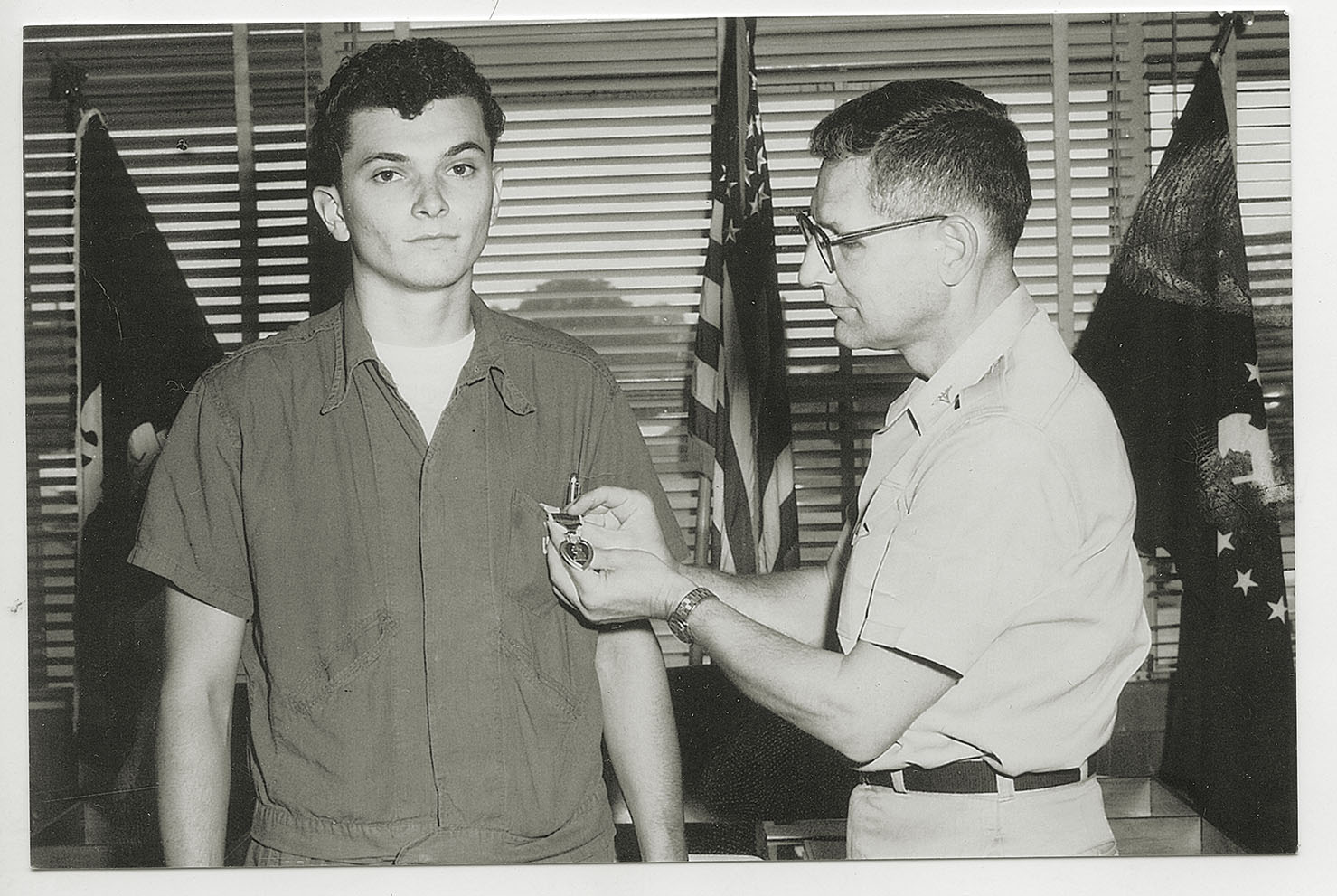
Sholly injured an ankle, and 1st Lt. Cary Allen took command of Company B. He pulled the company into a perimeter and dispatched 4th Platoon to recon the trail to the west, while 1st Platoon performed a similar mission to the east-southeast. The two platoons were to advance no more than 200 yards from the main body of the company.
Moving west down the trail, 4th Platoon exchanged fire with a single NVA soldier, then a handful and finally a group of about 10-15 around noon. Our chase after the enemy unwittingly led us into a large ambush. In an instant the jungle erupted in gunfire. As the entire platoon hit the ground, I saw guys crawling back toward me. We looked for cover and returned fire the best we could. I couldn’t see DeLong and didn’t know if No. 1 Gun was firing.
Surrounded by an enemy battalion, our hopelessly outnumbered platoon waged a desperate battle for survival. Around 3 p.m., when Grandstaff realized we were about to be overrun, he called in artillery right on top of our location. A battery of big 155 mm howitzers blasted the tiny platoon perimeter, tearing trees out of the ground and hurling chunks of red-hot shell splinters through the air. It was a chaotic nightmare.
Not long after the artillery barrage ended, the North Vietnamese swept through 4th Platoon and executed some of the survivors.
I had been shot in the back early in the battle and was lying behind a log with two other soldiers. I watched in horror as four NVA soldiers ambled through the branches of a downed tree that partially concealed us. One of them gazed in our direction, lowered his AK 47 assault rifle and fired six shots. Two rounds smashed into a log inches above my head. Amazingly, the NVA men then walked a short distance away, sat down and ate lunch. After about 30 minutes, the four enemy soldiers got up and left the area.
The 4th Platoon survivors stayed put for the night. Company A searched in vain for the platoon in the dark and finally found the shattered unit on the morning of May 19.
Overrun and utterly destroyed, the 30-man 4th Platoon had suffered 21 killed and one missing. Of the eight who remained, seven were wounded. The man listed as missing was machine gunner Joe DeLong, captured along with No. 1 Gun. DeLong was later killed attempting to escape from a North Vietnamese prisoner of war camp in Cambodia. He was posthumously awarded the Silver Star in 1974.
Ever since that fateful day in 1967, I have often wondered what became of my beloved M60. Was No. 1 Gun used to kill Americans? Was it left behind on some forgotten battlefield? Or is it on display in a Hanoi museum so curious citizens of that city can inspect a weapon captured from American “imperialists”? V
Victor Renza was sent home after he was wounded on May 18, 1967. Before he was drafted Renza had worked as a hairdresser for women in his hometown of Peekskill, New York. In Vietnam he cut the hair of everyone in his company for free. Back home he returned to hairdressing and got a job at Kenneth Salon in New York City working with top models and fashion magazine editors. He also worked on Jacqueline Kennedy’s hair pieces and wigs. In 1973, Renza opened his own salon in Peekskill. He retired in 2012 and lives in Delray Beach, Florida.
This article appeared in the October 2021 issue of Vietnam magazine.

